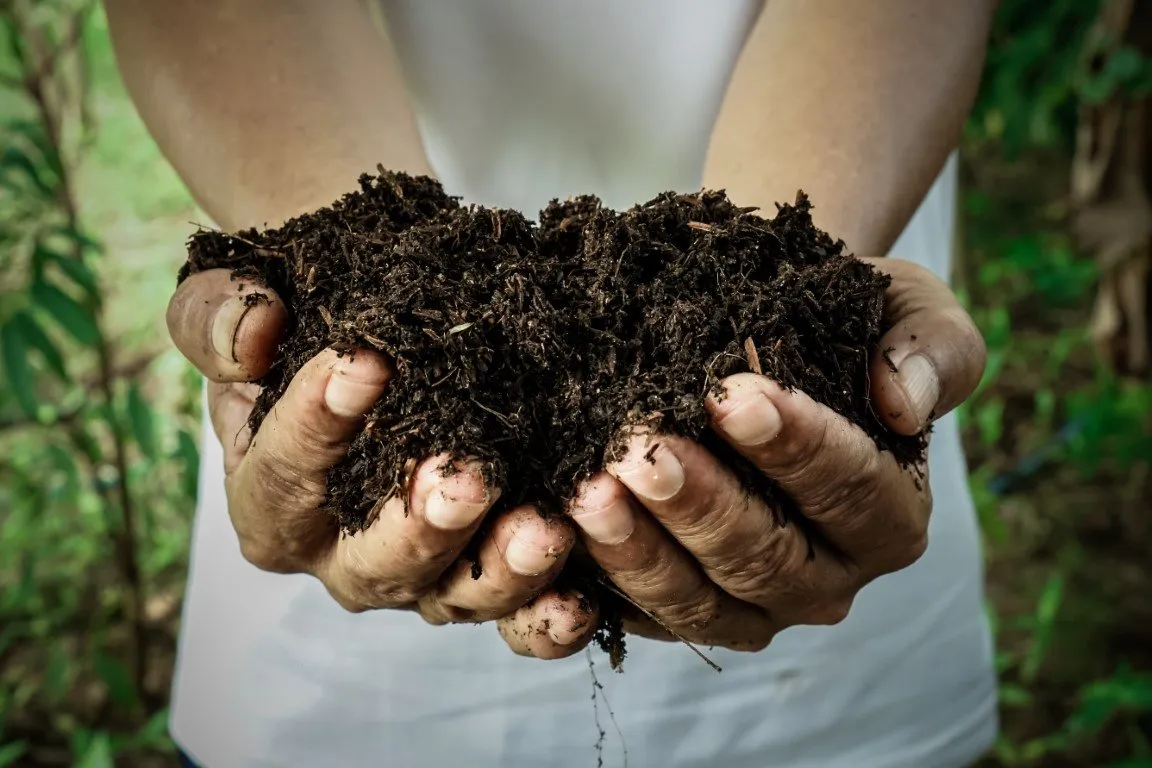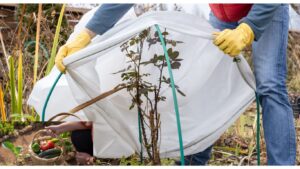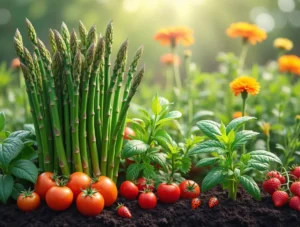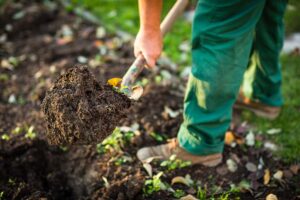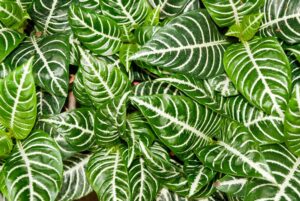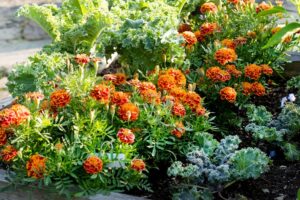Feeding your garden with organic fertilizers is crucial for sustaining plant health and promoting vigorous growth. Organic fertilizers not only provide essential nutrients but also improve soil structure and encourage beneficial microorganisms. Here’s how to use them effectively.
Understanding Organic Fertilizers
Organic fertilizers come from natural sources, such as compost, manure, bone meal, and fish emulsion. Unlike synthetic fertilizers, they release nutrients slowly, feeding plants over time and reducing the risk of nutrient runoff and environmental damage.
Types of Organic Fertilizers:
- Compost: Often referred to as “black gold,” compost is a powerhouse of nutrients and organic matter. It improves soil texture, increases water retention, and supplies plants with a balanced range of nutrients. You can make your own compost from kitchen scraps and garden waste or purchase it from garden centers.
- Manure: Well-aged manure, particularly from herbivores like cows, horses, and chickens, is rich in nitrogen, phosphorus, and potassium (N-P-K), essential for plant growth. It’s important to use only composted manure, as fresh manure can be too high in nitrogen and may burn plants.
- Bone Meal: Bone meal is a slow-release fertilizer rich in phosphorus, which is crucial for root development and flowering. It’s particularly useful for root crops like carrots and beets, as well as flowering plants.
- Fish Emulsion: This liquid fertilizer, made from processed fish, is high in nitrogen and other trace elements. It’s a quick-acting fertilizer that’s great for leafy greens and boosting overall plant vigor.
- Seaweed Extract: Seaweed is a source of potassium and trace minerals that help improve overall plant health and stress tolerance. It can be applied as a foliar spray or soil drench.
When and How to Apply Organic Fertilizers
Knowing when and how to apply organic fertilizers is key to maximizing their effectiveness. Different plants have different nutritional needs, and the timing of fertilizer application can influence growth, flowering, and fruiting.
- Pre-Planting: Before planting, mix compost or well-rotted manure into your garden beds. This not only enriches the soil but also improves its structure, making it easier for roots to grow. Spread a 2-3 inch layer of compost or manure over the soil and work it into the top 6-8 inches.
- During Planting: When transplanting seedlings, you can add a handful of bone meal or other slow-release fertilizer to the planting hole. This provides a steady supply of nutrients directly to the roots as the plant establishes itself.
- Mid-Season Fertilization: Depending on your crops, you may need to side-dress with additional compost or apply liquid fertilizers like fish emulsion during the growing season. For heavy feeders like tomatoes, peppers, and squash, apply a balanced organic fertilizer every 4-6 weeks to maintain nutrient levels.
- Foliar Feeding: Some plants benefit from foliar feeding, where fertilizers like seaweed extract are sprayed directly onto the leaves. This method is particularly effective for delivering trace elements and boosting plant health during periods of stress.
Balancing Nutrients: The Role of N-P-K
Understanding the role of nitrogen (N), phosphorus (P), and potassium (K) is essential for effective fertilization. These three macronutrients play different roles in plant growth:
- Nitrogen (N): Nitrogen is crucial for leafy growth and is especially important for vegetables like lettuce, spinach, and kale. However, too much nitrogen can lead to lush foliage at the expense of fruit and flower production.
- Phosphorus (P): Phosphorus promotes root development, flowering, and fruiting. It’s essential for root crops and flowering plants but is often less available in soils, especially those that are very acidic or alkaline.
- Potassium (K): Potassium enhances overall plant health, strengthens stems, and improves disease resistance. It also plays a key role in fruit and flower development.
- Using Organic Fertilizers with N-P-K: Most organic fertilizers are lower in N-P-K than synthetic ones but provide a more balanced and sustainable nutrient supply. For example, compost typically has an N-P-K ratio of around 1-1-1, while bone meal might have a higher phosphorus content like 3-15-0. Fish emulsion often has a ratio of about 5-1-1, making it rich in nitrogen.
Avoiding Over-Fertilization
One of the benefits of organic gardening is that it’s harder to over-fertilize compared to using synthetic fertilizers, which can easily lead to nutrient imbalances and plant damage. However, it’s still important to apply fertilizers thoughtfully.
- Signs of Over-Fertilization: Symptoms of over-fertilization include leaf burn, where the edges of leaves turn brown or yellow, stunted growth, and poor flowering or fruiting. If you suspect over-fertilization, reduce feeding and increase watering to help flush excess nutrients from the soil.
- Testing Soil Nutrients: Regular soil testing can help you determine the nutrient levels in your garden and guide your fertilization plan. Many local agricultural extensions offer soil testing services and can provide specific recommendations based on your results.
The Benefits of Organic Fertilization
Using organic fertilizers supports the health of your garden in multiple ways. By feeding the soil, not just the plants, organic fertilizers improve soil structure, encourage beneficial microbes, and create a sustainable growing environment.
- Promoting Soil Life: Organic fertilizers enhance the biological activity in your soil, supporting earthworms, mycorrhizal fungi, and other beneficial organisms that contribute to healthy plant growth.
- Sustainable Gardening: Organic fertilizers are derived from renewable resources and are biodegradable, making them an environmentally friendly choice. They reduce the need for chemical inputs and help maintain the long-term health of your garden ecosystem.
Natural Pest Control in an Organic Garden
Managing pests is a crucial aspect of maintaining a healthy organic garden. Without the use of synthetic pesticides, organic gardeners rely on natural methods to keep pest populations under control while preserving the balance of the ecosystem. Below, we’ll explore various strategies for effective natural pest control.
Understanding Common Garden Pests
To control pests effectively, it’s important to identify the most common culprits that may attack your garden. Here’s a look at some of the pests you’re likely to encounter and the damage they can cause:
- Aphids: These tiny, sap-sucking insects can be found on a wide range of plants. They cause leaves to curl, yellow, and stunt plant growth. They also excrete a sticky substance called honeydew, which can lead to sooty mold.
- Caterpillars: These larvae of moths and butterflies are notorious for munching on leaves, sometimes defoliating entire plants. Common types include the cabbage worm, tomato hornworm, and cutworms.
- Slugs and Snails: These pests thrive in damp conditions and can cause significant damage to seedlings and soft, leafy plants. They leave irregular holes in leaves and can quickly decimate young plants.
- Spider Mites: These tiny arachnids feed on plant sap and are particularly problematic in hot, dry conditions. They cause yellowing and stippling of leaves and can lead to severe plant stress if left unchecked.
- Whiteflies: These small, white-winged insects are often found on the underside of leaves. They suck plant sap and can cause wilting, yellowing, and stunted growth. Like aphids, they also excrete honeydew, leading to secondary problems like sooty mold.
Cultural Practices for Pest Prevention
The best defense against pests is a healthy garden. By implementing good cultural practices, you can create an environment that discourages pests and promotes plant health.
- Crop Rotation: Rotating crops each season disrupts the life cycles of pests that may overwinter in the soil. For example, rotating tomatoes with legumes can reduce the risk of soil-borne diseases and pests specific to tomatoes.
- Companion Planting: Some plants naturally repel pests or attract beneficial insects that prey on pests. For example, planting marigolds around your vegetable garden can deter nematodes, while planting basil near tomatoes can help repel whiteflies.
- Proper Watering: Overwatering or watering in the evening can create a moist environment that attracts pests like slugs and snails. Watering early in the morning and keeping the soil surface dry can help reduce these problems.
- Sanitation: Keeping your garden clean and free of debris can reduce the habitats where pests thrive. Remove weeds, old plant material, and fallen fruit regularly to minimize pest breeding grounds.
Introducing Beneficial Insects
Beneficial insects are a gardener’s allies in the fight against pests. These natural predators and parasitoids help keep pest populations in check, reducing the need for intervention.
- Ladybugs: Known for their appetite for aphids, ladybugs are one of the most beneficial insects in the garden. They also feed on soft-bodied insects like mites and scale insects. You can attract ladybugs by planting dill, fennel, and yarrow.
- Lacewings: Green lacewings are voracious predators of aphids, whiteflies, and other small pests. Their larvae, known as “aphid lions,” can consume hundreds of aphids in their lifetime.
- Parasitic Wasps: These tiny wasps lay their eggs inside or on the bodies of pest insects like caterpillars, aphids, and whiteflies. As the eggs hatch, the wasp larvae feed on the host, effectively controlling pest populations. Attract these beneficial wasps by planting nectar-rich flowers like cosmos, sweet alyssum, and parsley.
- Ground Beetles: Ground beetles are nocturnal hunters that prey on soil-dwelling pests like slugs, cutworms, and root maggots. Provide them with habitat by leaving some ground cover and avoiding excessive tilling.
Natural Pest Control Methods
When pest populations become problematic, natural control methods can be employed to manage them without harming the environment.
- Handpicking: For larger pests like caterpillars, slugs, and snails, handpicking is an effective and immediate method of control. Simply remove the pests and dispose of them in a bucket of soapy water.
- Neem Oil: Neem oil is a natural pesticide derived from the neem tree. It disrupts the life cycle of pests like aphids, whiteflies, and spider mites. It’s safe for beneficial insects when used correctly, but it should be applied in the early morning or late evening to avoid harming pollinators.
- Insecticidal Soap: This soap kills soft-bodied insects like aphids, mites, and whiteflies by disrupting their cell membranes. It’s a low-toxicity option that can be used on a variety of plants. However, it must come into direct contact with the pests to be effective.
- Diatomaceous Earth: This natural powder is made from the fossilized remains of diatoms, a type of algae. It’s abrasive to insects and can be sprinkled around plants to deter pests like slugs, snails, and beetles. Be sure to use food-grade diatomaceous earth and reapply after rain.
- Bacillus thuringiensis (Bt): Bt is a naturally occurring bacterium that produces toxins lethal to certain insect larvae, particularly caterpillars. It’s a targeted biological control that’s safe for humans, pets, and beneficial insects. It’s particularly useful for controlling pests like cabbage worms and tomato hornworms.
Using Barriers and Traps
Physical barriers and traps are another effective way to protect your garden from pests without the need for chemical interventions.
- Row Covers: Floating row covers can be used to protect plants from pests like aphids, flea beetles, and cabbage worms. They also offer protection against frost and can be used to extend the growing season. Make sure to secure the edges to prevent pests from getting underneath.
- Slug Traps: Slugs are notorious for causing damage in organic gardens, but they can be effectively managed with traps. Set up shallow containers filled with beer or a yeast solution around your garden. The slugs are attracted to the smell and will drown in the liquid.
- Sticky Traps: Yellow sticky traps can be used to monitor and control flying pests like whiteflies, aphids, and thrips. Place them near infested plants to reduce pest populations. These traps are particularly useful in greenhouses and enclosed garden spaces.
Integrated Pest Management (IPM)
Integrated Pest Management (IPM) is a holistic approach to pest control that combines multiple strategies to manage pests in the most environmentally responsible way possible.
- Monitor and Identify Pests: Regularly inspect your garden for signs of pests and correctly identify them before taking action. Not all insects are harmful, and some may be beneficial.
- Set Action Thresholds: Determine the level of pest activity that you can tolerate before intervention is needed. For example, a few aphids might not warrant action, but a large infestation that threatens plant health should be addressed.
- Use Control Methods Wisely: Start with the least invasive methods first, such as cultural practices and biological controls. Chemical controls, even natural ones, should be a last resort and used in a targeted manner.
